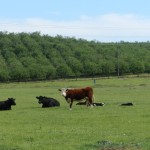
While everyone was watching salmon, someone robbed the water bank. That’s all we can conclude while watching another silly argument about fish while growers in eastern Stanislaus County drain one of the last great aquifers in the San Joaquin Valley.
Not that depleting aquifers is anything new around here. Well over fifty years ago we set a dubious record for subsidence, and by all appearances we’re hell-bent on breaking it almost on a yearly basis.
According to the United States Geological Survey, by 1959 the area between Los Banos and Kettleman City—some 1500 square miles—had the largest known incidence of subsidence in the world. The average throughout the area was then four feet overall and in some areas twenty feet and more. Needless to say, the water table is still shrinking and the land is still sinking.
In fact, rather than learn from our mistakes, we seem hell-bent on repeating them. Out in eastern Stanislaus County orchards are sprouting faster than garden weeds, all of them dependent on one of the last great aquifers in the valley.
Only last year, Modesto Mayor Garrad Marsh was touting our local water wealth as a prime attraction for businesses that could bring us much-needed jobs. That was before the belated recognition that our so-called “excess water” has been just another desert mirage, built from equal parts ignorance, hype, and deception.
Californians have always preferred to deny Mother Nature’s hard facts. Earthquakes, mudslides, all-consuming fires, floods, and droughts have never gotten in the way of our desires to bend nature to our own ends. And when nature doesn’t cooperate, we can always fall back on our default positions of denial and wishful thinking.
So when we divert eighty percent of the water out of the Tuolumne River and the fish suffer, we can always find a myriad of other reasons for the decline of salmon runs and fisheries in general. Just imagine reducing people’s water allotments by eighty percent. The outcry would be deafening and justified. But take eighty percent from Mother Nature and the result is a shrug and a dodge.
No one really wants to talk about draining aquifers and diverting water to land unsuited for farming, but both are primary causes for many of our water-related problems. Any good farmer knows that prime soil is best for farming. Among the major virtues of prime soil is permeability. Much of the water it uses for crops sinks back into the aquifer. Rocky soil and land where an impervious clay layer sits just below the surface are far less suitable for agriculture.
Stanislaus County Supervisor Jim DeMartini farms 1200 acres of some of the best farmland in the world. Ask him about the land in eastern Stanislaus County and he’ll tell you it’s good for two things—dry land farming and running cattle. Over the long term, misusing the land for other purposes can only cause harm.
DeMartini is well aware of the harmful effects of draining an aquifer. “The water they’re pumping is affecting the water table all around them,” says DeMartini. “This is a public policy issue and we’re going to have to do something about it.”
“Doing something about it” won’t be easy. While many California counties and water districts have instituted groundwater policies, many others have not. The result is often a groundwater free-for-all where those who get in first manage to deplete the resource before the public knows what’s happening.
Whether or not Stanislaus County will institute a groundwater policy in time to prevent further damage to the aquifer remains to be seen. Supervisor DeMartini has a tenacious commitment to taking on and accomplishing unpopular but necessary tasks. Despite strident opposition from developer interests, he was able to get our Local Area Formation Commission (LAFCO) to develop a strong agriculture mitigation policy. There’s bound to be equally fierce opposition to any attempts to restrict groundwater usage from those who benefit from short-term exploitation of the aquifer.
DeMartini sums up the situation in a few short words. “It won’t be pleasant,” he says.
